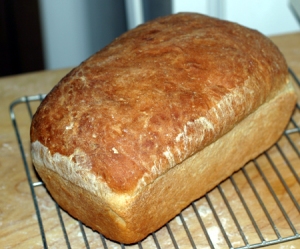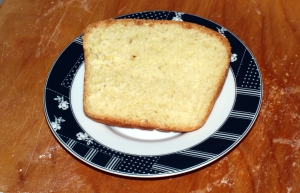White Bread 101 Yeast Rise (2 of 100)
March 30, 2014
This recipe courtesy of King Arthur was the one that got me started into the art of bread making and when I say art I really mean that as it has taken me a long time to perfect what I know up to this point. Changing your oil on your vehicle is pretty straight forward and there is only one way to do it. This is not true with making bread as different bakers proof yeast, temperature, kneading, rising, mixing, and baking differently. I’ve tried many different ways and I’ve finally settled on a system that works for me. My point is that there is no set way to do it and as you experiment you’ll find a system that you’re comfortable with. For example my days of rapping my knuckles to listen for that hollow sound is in my past. I invested a few dollars in a thermometer that measures the temperature of the loaf on the inside and when it reaches 190 degrees as an example this recipe, the loaf is done. I tent my bread with aluminum foil so the crust won’t get quite so brown. I bought clay tiles from Home Depot and put them on the middle shelf of my oven for much better even baking. I found that six of their standard tiles will fill a shelf. I measure my ingredients by volume but very carefully. No pinch of this and that but accurate as it does make a difference. While Walmart bargain brand flour will work I use only King Arthur as it is subjected to stricter quality control and overall offers higher protein which results in a nicer rise. I have an oven thermometer to get the exact temperature and most of the time I follow those instructions. For example this recipe calls for 350 for 40 minutes which means that I’ll tent after 25 minutes to prevent the bread from getting a crust that is too brown. I reserve the last five minutes for removing the bread from the pan and baking it on the clay tiles. It fills in the lighter areas on the sides to a brown color.
INGREDIENTS
3 cups unbleached King Arthur Flour
2 teaspoons instant yeast
1 1/4 teaspoons salt
3 tablespoons sugar
4 tablespoons stick butter salted
1/4 cup instant dry milk King Arthur Baker’s Special
1/3 cup potato flakes Potato Buds
9 ounces water, purified or filtered
1/16 teaspoon powdered ascorbic acid (vitamin C powder) If you’re lucky enough to have a smidgen measuring spoon that is just the right amount.
Mix flour, yeast, salt, sugar, dry milk, ascorbic acid, and potato flakes in bowl. I use the whisk attachment for my Kitchen Aid. Combine butter and water in separate measuring cup making sure it is slightly warm to the finger. I pour the liquid over the top surface of the dry ingredients and then give it a minute to absorb before I mix for 4 minutes using the dough hook attachment. If necessary you may add a tablespoon of water or flour. Water if there is flour on the bottom of the bowl and flour if the dough appears too sticky. When it is correct the dough will come out of the bowl in one mass. Knead by hand to make sure the dough feels supple and you can form it into a smooth round ball. Put in a buttered bowl and let it rise for one hour, double in size. I try to find a warm surface about 100 degrees. Being in Minnesota this can be hard to do so I will heat my oven for one minute at 170 and then put the covered bowl in the oven with the oven door cracked. Try to make sure it doesn’t get too hot or cold. Using a dough scraper put the dough on a floured surface kneading three or four times and then back in the bowl for a second rise which will usually take 1/2 hour. Form the dough into an 8 inch log making sure you seal the seam. When the edges are slightly above the top of the pan put it into the preheated oven at 350. I bake 30 minutes turning the pan once so I get even browning and then remove the bread from the pan and let it bake on the clay tiles for the final fifteen minutes allowing the sides to be browned.. A thermometer pushed into the center of the loaf should be 190-200. If not you’re in danger of not having the loaf fully cooked on the inside. You can also use a sprayer bottle with water spraying it during the final ten minutes to get a hard crust. Resist temptation and cool completely before cutting. In fact this bread if allowed to stale for 12 or so hours it will taste better. It makes a killer peanut butter and jelly sandwich. An excellent everyday bread. The sunrise music, Arizona in all its beauty, make for a good example of this bread. It is a great way to start your day with a slice of this toast.



April 2, 2014 at 5:23 am
Beethoven and Bread! What could be better!